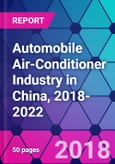An automobile air-conditioner system is a device for refrigerating, heating, ventilation and air purification. It can provide comfortable environment for occupants, reduce fatigue strength of drivers and enhance driving safety. An air-conditioner device has been perceived as one of the standards to measure automobile performances.The Market Size of Automobile Air-Conditioners Exceeded CNY 30 Billion in China in 2017 and the Annual Growth Rate is Expected to Maintain Over 10% from 2018 to 2022
The automobile air-conditioner industry develops rapidly along with the automobile industry in China. China has been the world's largest producer and distributor of automobiles for 9 years from 2009 to 2017. Its production volume of automobile air-conditioners exceeded 40 million units in 2017, among which more than 20 million was assembled in automobiles that were produced in China. In addition, a large number of air-conditioners were exported to international markets.
According to this research, foreign-invested enterprises have a prominent advantage in China's automobile air-conditioner market. Especially in the whole-vehicle OEM market, foreign-invested enterprises take up a majority of market shares. Chinese domestic air-conditioner manufacturers tend to cluster in Zhejiang province and Guangdong province. However, less advanced technologies of these domestic manufacturers force them to mainly serve the automobile aftermarket and domestic automobile brands. Leading enterprises in China's automobile air-conditioner market include Denso, Valeo, Delphi, Visteon and MAHLE. In terms of the passenger vehicle market, leading enterprises include Denso, Valeo, Visteon, Macs and Delphi and those in the commercial vehicle market include Nanjing Xiezhong, Hubei Meibiao, Dongfeng MAHLE and Valeo.
China's automobile air-conditioner market consists of the whole-vehicle OEM market and the aftermarket, among which the whole-vehicle OEM market represents a larger share. The market size of automobile air-conditioners in terms of value exceeded CNY 30 billion in China in 2017. The annual growth rate is expected to maintain over 10% from 2018 to 2022.
It is forecast that increasing production volume of automobiles, rising export volumes of automobile air-conditioners and components as well as development of new-energy automobile will act as major growth momentums in China’s automobile air-conditioner industry between 2018 and 2022, contributing to an increase in the unit cost of HVAV (heating, ventilation and air conditioning). Considering that the automobile and component manufacturing industry is one of pillar industries of Chinese economy, it is estimated that in the next few years, the Chinese government and local governments will publish a series of policies in favor of development of the automobile air-conditioner industry.
Readers can obtain the following information or more through this report:
- Economic and Policy Environment Faced by Automobile Air-Conditioner Industry
- Development Status of Global and Chinese Automobile Industry
- Analysis on Automobile Air-Conditioner Industry Chain
- Analysis on Supply and Demand of Automobile Air-Conditioners
- Price Trend of Raw Materials of Automobile Air-Conditioners
- Analysis on Competition in Automobile Air-Conditioner Market
- Major Automobile Air-Conditioner Manufacturers in China
- Analysis on Export of Automobile Air-Conditioners in China
- Driving Forces and Market Opportunities of Automobile Air-Conditioner Industry in China, 2018-2022
- Risks and Challenges Faced by Automobile Air-Conditioner Industry in China, 2018-2022
- Forecast on Supply and Demand of Automobile Air-Conditioners in China, 2018-2022
Table of Contents
Companies Mentioned
- Air International Shanghai Co., Ltd
- Bergstrom
- Chongqing Chaoli Hi-Tech Co., Ltd.
- Delphi
- Denso
- Guangzhou Jingyi Automobile Air-Conditioner Co., Ltd.
- Halla-Visteon
- Hubei Meibiao Automobile Air Conditioner Systems Co., Ltd.
- MAHLE
- Mitsubishi Heavy Industries
- Nanjing Xiezhong Automobile Air Conditioning Co., Ltd.
- SANDEN
- Songz Automobile Air Conditioning Co., Ltd.
- Suzhou New Tongchuang Auto Air-Conditioning Co., Ltd
- Valeo
- Yuxin Automobile Air Conditioning Co., Ltd.
- Zhengzhou Kelin Motor Vehicle Air Conditioning Co., Ltd.
Methodology
Background research defines the range of products and industries, which proposes the key points of the research. Proper classification will help clients understand the industry and products in the report.
Secondhand material research is a necessary way to push the project into fast progress. The analyst always chooses the data source carefully. Most secondhand data they quote is sourced from an authority in a specific industry or public data source from governments, industrial associations, etc. For some new or niche fields, they also "double-check" data sources and logics before they show them to clients.
Primary research is the key to solve questions, which largely influence the research outputs. The analyst may use methods like mathematics, logical reasoning, scenario thinking, to confirm key data and make the data credible.
The data model is an important analysis method. Calculating through data models with different factors weights can guarantee the outputs objective.
The analyst optimizes the following methods and steps in executing research projects and also forms many special information gathering and processing methods.
1. Analyze the life cycle of the industry to understand the development phase and space.
2. Grasp the key indexes evaluating the market to position clients in the market and formulate development plans
3. Economic, political, social and cultural factors
4. Competitors like a mirror that reflects the overall market and also market differences.
5. Inside and outside the industry, upstream and downstream of the industry chain, show inner competitions
6. Proper estimation of the future is good guidance for strategic planning.

LOADING...








